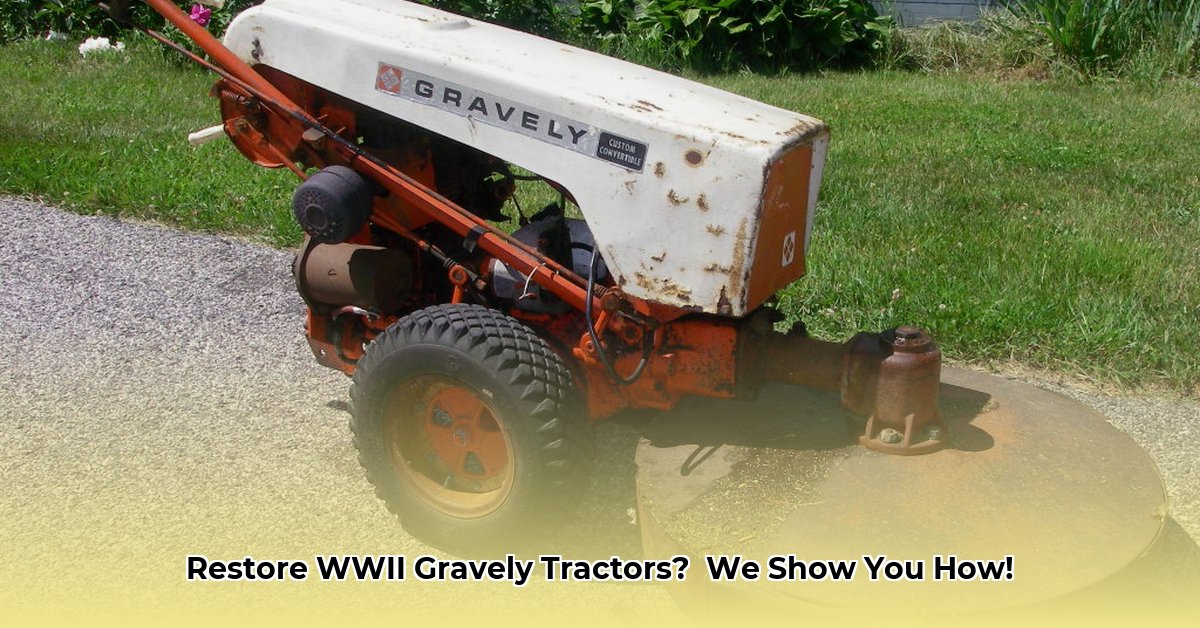
Old Gravely Tractors: A Restoration Journey Through Time
Bringing a vintage Gravely tractor back to life is a rewarding blend of history, mechanics, and dedicated effort. These machines, once agricultural workhorses, offer a unique connection to the past and a chance to preserve a piece of American heritage. This guide explores their evolution, from wartime ingenuity to modern restoration techniques. For more on vintage tractors, check out this helpful resource: Old Tractor Info.
Wartime Innovations and Post-War Adaptations
World War II drastically impacted Gravely production. Material shortages forced innovative solutions. Cast iron replaced some engine components, tin substituted for brass serial number tags, and steel and wood replaced original materials in other parts. These adaptations highlight the ingenuity of the era. The post-war period saw a return to original designs and materials as supplies stabilized, but the wartime modifications left a lasting impact on the tractors' design and longevity. Research continues to uncover details about these compelling wartime changes.
Did you know that even seemingly minor material substitutions, like using tin instead of brass, significantly impacted the long-term preservation of these historical tractors? This resourceful approach, born out of necessity, makes these wartime Gravelys particularly fascinating to collectors.
Identifying Your Gravely: Model Identification
Precise model identification is crucial for successful restoration. Early models (pre-1940s) differ significantly from later models. Even within the same year, variations exist. Meticulous research using original manuals and serial numbers is essential for accurate identification.
Here's a simplified comparison:
| Feature | Early Models (Pre-1940s) | Mid-Range Models (1940s-1960s) | Later Models (1970s Onwards) |
|---|---|---|---|
| Engine | Smaller, less powerful Kohler engines. | More powerful Kohler engines; some with alternators. | Larger engines; improved cooling and lubrication systems. |
| Transmission | Simpler designs; prone to issues. | Improved gearing and reliability. | More robust design; fewer common issues. |
| Key Materials | Primarily cast iron, steel, and wood; parts scarcer. | Improved material availability; return to original designs. | Readily available, more durable materials. |
(Note: This is a simplified comparison. Detailed specifications require extensive research.)
Troubleshooting and Maintenance: Keeping Your Gravely Running
Older Kohler engines, particularly in early Gravely models, suffered from insufficient oil supply, especially on slopes, leading to internal damage. Preventative maintenance is paramount.
Essential Steps:
- Regular Oil Changes: Use the correct viscosity for your engine and climate.
- Oil Level Checks: Check oil before each use.
- Engine Inspections: Regularly inspect for leaks, wear, and damage.
Your Gravely's manual provides model-specific maintenance instructions.
Parts Sourcing and Restoration Strategies
Finding original parts is challenging. Online forums for classic tractors, specialized parts suppliers, and even local scrapyards can be valuable resources. Consider high-quality reproduction parts when originals are unavailable.
Restoration Steps:
- Disassembly: Systematic disassembly with detailed photos and notes.
- Cleaning: Thorough cleaning with appropriate agents.
- Repair/Replacement: Repair or replace damaged/worn parts.
- Reassembly: Careful reassembly, following your notes.
- Testing: Thorough testing of all systems.
Legal and Safety Considerations
Always comply with local and national regulations for the restoration and operation of vintage machinery. Safety is paramount. Inspect your equipment before each use, and ensure any modifications meet safety standards.
Restoring a Gravely is a rewarding journey combining history, mechanics, and problem-solving. This guide provides a foundation for your restoration project. Remember, patience and persistence are key to success.
How to Troubleshoot Early Kohler Engine Issues in Gravely Tractors
Key Takeaways:
- Early Kohler engines in Gravely tractors are prone to specific issues.
- Preventative maintenance (regular oil changes, oil filter addition) extends engine life.
- Overheating and valve failure are common, often linked to power-hungry attachments.
- Repowering is a costly but potentially reliable solution.
- Aftermarket or used engines offer budget-friendly alternatives, with potential reliability compromises.
Gravely's Wartime Legacy and Common Problems
Gravely tractors contributed significantly to American agriculture during WWII. Material limitations created design compromises that continue to pose challenges for modern restoration efforts.
The Kohler K-series engines, often found in models like the 16G, have known weaknesses:
- Overheating and Valve Issues: Overheating leads to burnt valves, exacerbated by power-hungry attachments.
- Lack of Oil Filtration: Many lacked an oil filter; adding one is strongly recommended.
- Bottom-End Wear: Neglecting oil changes leads to wear on crankshaft and connecting rods.
Solutions: Maintenance and Repowering
- Regular Maintenance: Essential for preventing costly repairs.
- Troubleshooting: Diagnose overheating by inspecting the cooling system; low compression points to valve, ring, or piston issues.
- Repowering: Consider a Kohler repower kit, a used Kohler engine, or a more budget-friendly (but potentially less reliable) alternative like a Harbor Freight Predator engine. Each option has its own cost and reliability considerations.
Sourcing Parts and Resources
Finding original parts can be challenging. Utilize online forums, specialized parts suppliers, and reproduction parts where necessary. Remember this is a journey requiring diligence and patience.